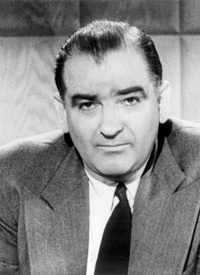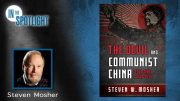
That happened more than 50 years ago — before I went off to college and found myself amongst a swarm of others telling me that McCarthy was a scoundrel, that he unfairly and viciously attacked innocent people, and that America had nothing to worry about because there really weren’t any communists or communist sympathizers in government.
Blacklisted by History: The Untold Story of Senator Joe McCarthy, by M. Stanton Evans, New York: Crown Publishing Group, 2007, 664 pages, hardcover.
In the early 1950s, I’d never heard of Elizabeth Bentley, Whittaker Chambers, Samuel Klaus, and several others who had already sounded grave and credible warnings about the communist penetration. Elizabeth Bentley had served the Communist Party as a courier carrying messages and data from one spy cell to another in Washington and New York. She gave her information to the FBI in 1945, but nothing was ever done about her revelations until Joe McCarthy emerged. Whittaker Chambers, the former communist who told State Department officials in 1939 that the Roosevelt administration was loaded with communists, and who was the key figure in the exposure of top State Department official Alger Hiss as a communist agent, stated in one of his books that he felt he had left the winning side (the communists) and joined the losing side (those loyal to America). In 1946, State Department official Samuel Klaus delivered his lengthy memo to superiors detailing communist infiltration at the State Department but nothing was done. Bentley, Chambers, Klaus, and others had sacrificed much — even placed themselves in jeopardy — for what seemed to be nothing. McCarthy eventually made their efforts meaningful.
Nor did I have in the 1950s the benefit of digesting the amazing Venona Intercepts, the back-and-forth messages between Moscow and their U.S. agents during and after the 1940s. The contents of these messages, known to government officials as they were being transmitted and transcribed for posterity, confirmed the identities of those communist agents inside our country and inside our government. Again, nothing was done to remove the communists, however. Though these Venona documents provided corroboration for what McCarthy would later charge, they weren’t made available to the American public until 1995.
Another treasure trove of information vindicating McCarthy became available during the apparent demise of Soviet communism in the early 1990s. Not only were many Kremlin files opened for inspection by researchers from our country, so too were the records in various former Soviet satellite capitals. Author Stan Evans took the time to avail himself of all of this information, dig more deeply into the files of the FBI and other government agencies, and put all this material together in a single volume to show that Joe McCarthy should be praised, not condemned.
Over the years, scores of books have been written about the Wisconsin senator’s campaign to rid the U.S. government of internal enemies. Almost all of these volumes condemned him as a disreputable rogue. A few buttressed my father’s opinion: McCarthy was correct and he attempted to do what many other senators and congressmen should have been doing to protect this nation. But those that could have been called pro-McCarthy were scorned.
All the books about McCarthy, both pro and con, must now stand aside. In Blacklisted by History, Stanton Evans has produced a masterful, scholarly, and extremely thorough 664-page compilation of evidence completely exonerating the man whose name has been made a detestable symbol of “unfair accusations” and “rogue investigative techniques.”
Evans supplies the details any critic would need to reverse the popularly held view of the Wisconsin senator. According to Evans, McCarthy began his crusade against the communist penetration of the U.S. government with a February 1950 speech at a Republican gathering in Wheeling, West Virginia. He had been provided with a copy of the Klaus memo, found it credible, and told his audience about its contents. Liberals and pro-communists, using both infuriating and laughable “evidence,” have sought to debunk what McCarthy said on that single occasion. Evans tells the whole story.
The important Klaus memo disappeared from government records, but Evans located a copy and published it in its entirety as an appendix. In the book’s prologue, the widely read author, editor, columnist, and commentator who trained hundreds of young conservatives at the National Journalism Center in Washington over the past 30 years gave a backdrop on his sleuthing and told of unearthing “once secret records of the FBI” that helped to make the case for defending McCarthy. The FBI knew the truth at the time, but as a gatherer of information wasn’t free to publicize what it knew, and many of its personnel waited in vain for government officials to call for airing its information in public sessions.
In his book, Evans details the information the FBI was privy to: “The Bureau knew as early as December 1942 that J. Robert Oppenheimer, the nuclear physicist then becoming a central figure in the [U.S. government’s top-secret] atomic energy project, was identified by Communist leaders as a secret party member who had to be inactive because of the wartime work that he was doing. Likewise in 1945, the FBI obtained credible information that high-ranking government figures Alger Hiss, Lauchlin Currie, and Harry Dexter White were Soviet agents. Also in 1945, the Bureau knew the espionage case of John Stewart Service and the pro-Red magazine Amerasia had been fixed, lied about, and covered up by a cabal of top officials.”
For readers who know little or nothing about these individuals, consider that Oppenheimer has always been reasonably thought to have been the key individual who supplied the Soviet Union with nuclear weapons technology. Alger Hiss wormed his way into government so ably that he was at President Roosevelt’s side as a key adviser at the 1944 wartime Yalta Conference attended by the “Big Three” — Roosevelt, Churchill, and Stalin. At this summit, it was agreed to betray post-war Eastern Europe and Manchuria into the hands of the communists. Hiss then secured the appointment as secretary-general of the UN founding conference in 1945 where he was able to welcome a score of fellow communists into the U.S. delegation at that gathering. Harry Dexter White, a close associate of Hiss, arranged to deliver engraved plates to print U.S. currency to the Soviet Union, became Secretary of the Treasury, and participated in the formation of the UN’s International Monetary Fund which he later led. And Lauchlin Currie held down an office in the White House where he served as a top adviser to President Roosevelt. Each of these extremely key individuals was loyal to the Soviet Union, not to the United States.
Evans recounts many of the details surrounding the pro-communist State Department official John Stewart Service, one of many government officials targeted by McCarthy. Service was a leader of the infamous Institute of Pacific Relations that played an important role in the sellout of China to Mao Tse-tung and his communist forces during the late 1940s. When McCarthy produced reliable information about Service’s communist background, Truman administration officials weren’t interested in removing Service; they, instead, desperately sought to impede the McCarthy effort. Evans explained: “John Service had been kept on the State Department payroll for five full years after passing papers to Philip Jaffe, confidant of Communist bosses and Soviet agents; but anyone caught passing data to Joe McCarthy concerning Service himself would be out on his ear by sundown.”
Blacklisted by History is surely not a partisan political treatise. Evans is especially hard on Truman’s Secretary of State, Dean Acheson, even on the president himself and with good reason. But when Dwight Eisenhower took office in 1953 and McCarthy thought he might receive the kind of cooperation one would expect from a U.S. president, business as usual continued. Democrat or Republican in high office, it didn’t matter. McCarthy wanted to rid the government of disloyal employees. But, over and over again, McCarthy himself, not the obvious communists and pro-communists, was the target of our nation’s top officials.
As Evans shows, McCarthy became the subject of investigations by other Senate committees and their pro-communist leaders. His extremely valuable research assistant, J.B. Matthews, was driven out of staff service by a combined attack led by the left-wing media and pro-communist forces in government. And when the senator aimed his efforts at rooting out pro-communist influence at the Army’s sensitive Signal Corps facility at Fort Monmouth, New Jersey, the anti-McCarthy forces converted a proper investigation into a carnival designed to make McCarthy look like a clown or a vicious cutthroat willing to smear innocent people with false charges. If you want the proof, read Evans’ book!
After listing the various accomplishments attributable to McCarthy’s efforts — the many pro-communists who fled government service, the tighter security procedures, and the admission by officials that there had been foul-ups followed by corrective measures — Evans recounts the true circumstances behind, and actual language of, the Senate vote to condemn the senator. (Hint: it was not a repudiation of his allegations.) Then, in obvious sadness, he relates that McCarthy “became a non-person to be ignored and shunned, a ghost figure with no relation to the serious business of the Senate.” But, according to Evans, Joe McCarthy “was a good man and true — better and truer by far than the tag teams of cover-up artists and backstage plotters who connived unceasingly to destroy him.”
No serious scholar of the McCarthy era will be able to avoid this compelling and factual account of the valiant senator from Wisconsin.



